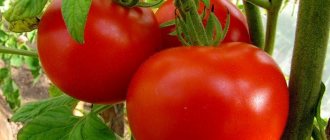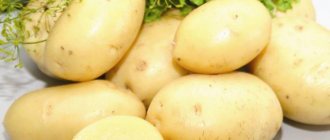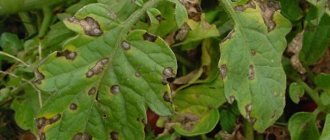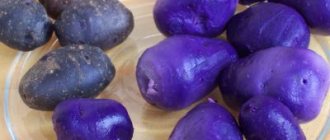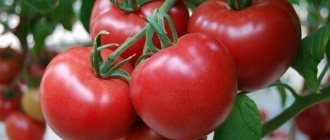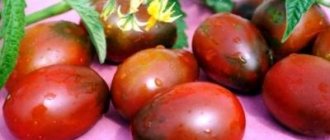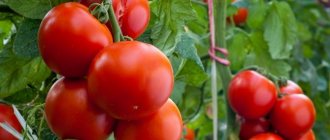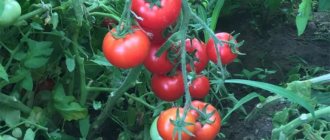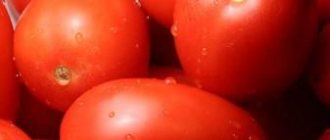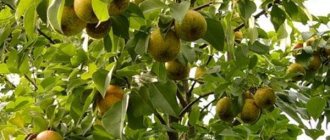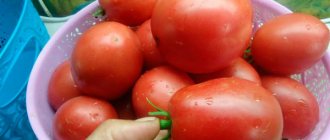Choosing tomato varieties for your summer cottage should, of course, take into account the climatic characteristics of this particular region. In the middle zone, in the Urals or in Siberia, it is worth planting, for example, tomatoes that are resistant to cold weather. Summer residents of the southern regions have the opportunity to choose varieties primarily based on the yield and taste of the fruit. One of the best hybrids intended for growing in warm climates, according to gardeners, is the Cornabel F1 tomato. This productive variety with unusual fruits has earned very good reviews from gardeners.
By whom and where was it bred?
This wonderful variety is very popular among domestic summer residents. However, the Cornabel F1 tomatoes were not bred in Russia. This hybrid was created by specialists from the French company Vilmorin. Cornabel F1 was officially registered in 2003. The variety quickly gained popularity among French vegetable growers for its high yield and excellent commercial quality of the fruit. Later, Cornabel F1 began to be grown in other European countries. After some time, these tomatoes were also appreciated by domestic summer residents.
Actually, the Vilmorin company itself has been on the market since 1743. The planting material sold by this company is considered one of the highest quality in Europe. Many domestic summer residents also give high marks to Vilmorin seeds.
Tomato Cornabel F1: general description
This variety belongs to the group of mid-season varieties. The fruits of this hybrid begin to ripen approximately 110 days after planting. As already mentioned, these tomatoes are intended for growing in warm climates. In Russia, this modern hybrid has earned particular popularity among gardeners in the Krasnodar and Stavropol Territories. It is from summer residents of the southern regions of the Russian Federation that there are the best reviews on the Internet about Cornabel F1 tomatoes. According to gardeners, these tomatoes are simply ideal for warm climates. But of course, you can plant such tomatoes in the middle zone, in the Urals or in Siberia. However, in cold regions, Cornabelle F1, of course, will have to be grown in a greenhouse.
This modern hybrid, among other things, belongs to the group of indeterminate varieties. That is, its growth is not limited by anything. In open ground or in a greenhouse, judging by the reviews of summer residents, these hybrids usually grow up to 170 cm during the season. Photos of Cornabelle F1 tomatoes are presented to the reader’s attention on the page. As you can see, these tomatoes actually grow very tall.
What other characteristics does the Cornabel F1 tomato have? The root system of this variety, like almost any other indeterminate variety, is branched. At the same time, the stems of Cornabelle F1 are usually thick and powerful. This hybrid has a low degree of foliage. Cornabelle F1 bushes are well ventilated, which eliminates the possibility of shoots rotting or the development of diseases associated with high humidity.
On the central shoot of Cornabelle F1, up to 5 clusters are usually formed per season. Each inflorescence usually contains 5-7 ovaries.
Yield volume and ways to increase it
High-yielding hybrid. But if you want to get the maximum yield, you should adhere to the following rules:
- Plant bushes often, but form them strictly into one trunk. This will increase the number and size of the fruit.
- Horizontal landing. New stepsons grow with their own root system. They form into an independent plant and produce a harvest.
- Biostimulants can be used. They are not harmful to humans, and can increase the yield quite well.
See also
Characteristics and description of the tomato variety FlashRead
Fruit
Cornabelle F1 tomatoes have earned good reviews from gardeners primarily for their high productivity. Another advantage of these tomatoes is the unusual shape of the fruit. Externally, Cornabelle F1 tomatoes resemble huge red peppers. The shape of the fruits of this hybrid is elongated, tapering downward. Tomatoes of this variety can reach 15 cm in length. The weight of the largest fruits is often 0.5 kg. On average, the weight of tomatoes of this hybrid is 200 g.
Gardeners also have a very good opinion about the taste of Cornabelle F1 tomatoes. The pulp of the fruits of this hybrid is sweet and sour, very juicy, slightly grainy. The skin of this variety of tomatoes is very dense.
How to grow
When the sprouts become stronger and reach a height of 30 cm, they can be transplanted into open ground. Before planting, the beds must be loosened and weeded to remove weeds. The area for tomatoes should be sunny.
Landing
In the area allocated for planting, holes are made to a depth of 15 cm and spilled with water. Since the Cornabel f1 hybrid is in constant growth, the seedlings are planted 0.5 m apart, and a gap of up to 1 meter is made between the rows. Thus, no more than two bushes should grow per 1 sq.m.
The seedlings are carefully removed from the pots and placed in holes prepared in advance. Cover with soil, without pressing down the soil too much, so as not to spoil the roots. Water again with warm water.
Care
For active growth, tomatoes need to be provided with proper watering. When the seedlings have not yet grown strong, 0.5 liters of water for each plant is enough. As the bush grows, the amount of water is increased. It is necessary to water with settled warm water. Watering in the sun is not allowed, as it will burn the leaves and stem.
The optimal time for watering is morning or evening. Watering is carried out as the earthen clod dries. Excessive watering can lead to fungal diseases and blackleg. The soil should not be allowed to dry out. In this case, growth will stop and the plant will die.
Planted plants must be regularly weeded and the earthen ball fluffed up. This will have a positive effect on the ventilation of the root area of the plant.
For the Cornabel variety, to form a beautiful bush, you must pinch off the extra shoots. Weak branches will produce small fruits. The top of the bush also needs to be pinched for the growth of large side branches. The growth of stepchildren must be constantly monitored as the bush grows, since their growth weakens the mother bush, robbing it of nutrients. It is recommended to form the plant using a two-stem system.
For this hybrid, a garter to a support is also necessary, since the bush grows tall and powerful and can simply collapse under the weight of the fruit. To do this, they dig in high supports and, as they grow, tie the stem with soft ropes.
7 days after planting the seedlings, fertilizing is done. The first feeding is done with a weak solution of chicken manure or cow manure. Subsequently, watering is carried out with a moderate content of mineral fertilizers. Excessive nitrogen content leads to abundant green growth. An excess of potassium prevents the bush from absorbing calcium, and can increase the fruit mass so much that the growth of the bush itself slows down.
Fertilizing is carried out as soon as the color of the foliage begins to change and the growth of the stem slows down.
Don’t forget about regular weeding, because only in soft, loose soil can you achieve a good harvest. Weeds pull minerals and organic matter necessary for tomatoes from the ground. Pests and harmful microorganisms appear in clogged areas.
Features of cultivation and possible difficulties
Kornabel for open ground is grown by seedlings. Before the onset of stable heat, cover the seedlings at night to prevent hypothermia. Growing this hybrid is not much different from growing conventional tomato varieties. The only difficulty is that the bush must be regularly shaped and, as the stem grows, constantly tied to a support.
Diseases and pests
The hybrid has good resistance to diseases and pests. But if you violate cultivation practices, diseases may arise - late blight, gray rot, black leg, leaf mosaic, bacteriosis.
Late blight appears when there is increased dampness and lack of loosening of the soil. The appearance of gray rot is promoted by fungi that are found in the soil at high atmospheric humidity. The cause of blackleg is also dampness. The mosaic on the leaves appears due to aphids. Most often this happens after a pick. Affected leaves should be picked and destroyed. The bushes are treated with fungicides: Fundazol, Maxim, Barrier, Skor.
With rare weeding, plants are affected by pests such as: whitefly, spider mites, armyworms, nematodes, and caterpillars. To combat them, you can use the drugs Actellik, Aktara, Bi 58-new.
Tomato reviews: advantages
In addition to the high yield and excellent taste of the fruit, gardeners include the following advantages of the Cornabel F1 hybrid:
- ease of care;
- resistance to various kinds of diseases.
Gardeners also consider the advantage of this variety to be that all the fruits ripening on such bushes are the same size. As many summer residents note, these tomatoes are also always distinguished by their beautiful and neat shape. All the fruits on the bushes look exactly like peppers. At the same time, ugly - bent, undergrown or overgrown tomatoes - do not develop on the plants. Of course, gardeners consider good keeping quality and transportability of Kornabel F1 fruits to be an advantage.
Of course, among the advantages of tomatoes of this variety, gardeners include their resistance to diseases. Vilmorin specialists claim that in this hybrid, immunity to various types of fungi and viruses is inherent at the genetic level. Indeed, many summer residents note that Cornabel F1 tomatoes get sick much less often than other popular varieties in our country, both domestic and foreign.
Advantages and disadvantages
Pros:
- original and beautiful fruits of almost the same size;
- taste;
- universal use;
- long fruiting;
- resistance to stressful conditions and the ability to set fruit in unfavorable weather;
- transportability of tomatoes;
- productivity;
- seeds remain viable for a long time (up to 6 years);
- immunity to fusarium, mosaic, verticillium.
Minuses:
- the inability to obtain seeds from your own harvest due to the high cost of purchased seeds.
Interesting fact
In terms of productivity and endurance, therefore, according to summer residents, the Cornabel F1 tomato variety has very good characteristics. And the description from the manufacturer, as well as reviews from summer residents, confirm this. Among other things, this interesting variety stands out among others with two interesting features.
As already mentioned, gardeners are attracted to Kornabel, among other things, by the unusual shape of its fruits. These large pepper-shaped tomatoes really look quite original. These tomatoes have another interesting feature. According to Vilmorin specialists, Cornabel is currently the only hybrid in the world with a high dry matter content. As many summer residents note, the pulp of these tomatoes really has a rather unusual taste. In addition, it is also distinguished by its high density. That is why tomatoes of the Cornabel F1 variety can be stored for a long time without spreading, and can also easily withstand long-distance transportation and heat treatment during salting or pickling.
Application
Most often, all summer residents use this variety for preservation as a whole. But, besides this, they are perfectly used for preparing fresh salads and decorating the holiday table. “Cornabel” is used very well for drying. These tomatoes are very expensive in the store, so you can make them at home yourself. They retain a large number of beneficial properties and qualities inherent in fresh fruit. Versatile tomatoes, perfect on the outside and very tasty. Therefore, they are eaten without any processing, eating freshly picked vegetables from the garden.
Landing Features
The technology for growing Cornabelle F1 tomatoes is usually used by summer residents as standard. These tomatoes are grown in the same way as any other indeterminate hybrids. Tomatoes of this variety are sown for seedlings in late February - early March. In any case, these tomatoes should be planted approximately 2 months before transferring them to open ground.
There is no need to prepare the soil for Cornabelle F1 seedlings in any special way. To grow such tomatoes on a windowsill, ordinary garden soil fertilized with organic matter is suitable. The only thing is that before sowing the seeds of this hybrid, you should definitely spill boiling water on the soil. This operation must be performed one day before disembarkation.
How to grow
Growing tomatoes of this variety does not require any special procedures. Everything is done in the same way as when planting any other varieties. The exception is that the bushes must be formed. Tomatoes are grown in greenhouses and open ground. Seeds for seedlings are planted at the end of March, beginning of April. The soil intended for planting seeds can be additionally fertilized. By introducing organic fertilizers and mineral additives:
- Potassium.
- Phosphorus.
- Nitrogen.
An excess of potassium is detrimental for this variety. A high potassium content leads to an increase in the weight of the fruits; the plant cannot hold them. It also interferes with the absorption of calcium. When the plant has 2 full-fledged leaves, they are picked. Before planting, you can feed the seedlings. It is recommended to harden the seedlings, take them out to the balcony, or just outside, 2-3 weeks in advance. Then, based on the weather conditions of the region, the tomatoes are planted in the ground. It is advisable that the seedlings have not yet bloomed. This way it will take root more easily and grow faster.
Form "Cornabel" into one trunk. Be sure to tie it to a support. Sometimes a plant produces too many fruits without forming a bush. As a result, the tomato will suffer; human intervention is necessary. You can increase the percentage of humidity, this will give the bush strength to grow green mass. They do this through short but short-lived watering. Another way to help the plant leave side shoots is by forming the plant into not one, but 2-3 stems.
Features of care
Judging by the description and reviews given by the manufacturer, the Cornabel F1 tomato is distinguished, among other things, by its unpretentiousness. However, of course, you need to care for tomatoes of this variety correctly.
In a permanent place, Cornabel F1 tomatoes are planted at a distance of approximately 40-50 cm from each other. It is believed that for good fruiting, bushes of this hybrid should be placed in such a way that there are no more than 3 of them per 1 m2. Of course, for tomatoes of this variety, supports should be installed next to the beds before planting.
As experienced gardeners note, it is not worth watering Cornabelle F1 tomatoes too often in the summer season. Otherwise, their fruits may become watery. Typically, summer residents moisten the soil in the beds under this hybrid no more than 1-2 times a week. It is especially important to reduce the intensity of watering these tomatoes during the period of fruit ripening.
Cornabelle F1 tomatoes are fertilized for the first time 2 weeks after planting. At this time, it is best to water them with slurry. The second feeding of tomatoes is done after flowering. In this case, potassium sulfate or superphosphate is usually used. For the third time, tomatoes are fertilized with organic matter during the fruiting period.
The bushes of this hybrid do not grow too dense. However, these tomatoes, like any other indeterminate tomatoes, should be shaped correctly. Typically, summer residents leave no more than 1-2 stems in Cornabel F1 bushes.
Optimal timing for cultivation
It is better to plan sowing of tomato grains for seedlings at the end of February - beginning of March, depending on the climatic characteristics of the cultivation region. It is important that before transplanting to a permanent location, the stems become stronger and develop strong roots. To do this they will need at least 60 days.
Please note that indeterminate hybrids need to be sown several weeks earlier than other varieties. However, seedlings should not be allowed to overgrow. The seedlings must be in an open area before they begin to flower. Otherwise, they will not take root or will be stunted.
When growing Cornabel in greenhouses, the sowing time depends on the material and features of the covering structures. For example, in heated structures, tomatoes should be planted at the end of April. But in greenhouses that are equipped with an additional internal covering layer of polyethylene, it is better to do this in the first ten days of May. The same deadlines should be observed when you plan to plant tomatoes in a polycarbonate greenhouse. If there is no additional shelter or heating units in the room, it is better to start planting seedlings after the 20th of May.
Equally important is the condition of the soil, as well as the air temperature in the greenhouse. Ideally, the substrate should be heated to a stable +15°C, and the air to +20°C.
Regardless of the place and method of growing the hybrid, in the fall you need to prepare the soil, enriching it with the main nutritional components (nitrogen, phosphorus, potassium).
Did you know? Tomato monuments have been erected in the Ukrainian cities of Kamenka-Dneprovskaya and Tsyuryupinsk
.
Pest protection
In Russia today, many summer residents are growing Cornabel F1 tomatoes. In the photo on the page, the bushes of these tomatoes, as you can see, look very powerful, and the fruits are neat. In exactly the same way, judging by the reviews of summer residents, this is the case in reality. Tomatoes of this variety always look strong and almost never get sick.
Cornabelle F1 tomatoes are protected at the genetic level from infectious diseases. However, these tomatoes, like any others, unfortunately, are not immune from insect attacks. Tomatoes of this variety can be damaged, for example, by aphids, spider mites, nematodes, caterpillars, etc. When attacked by such insects, experienced summer residents advise spraying Cornabel F1 tomatoes with some effective insecticide. This could be, for example, “Aktara”, “BI-58”, “Aktellik”, etc. Before planting tomato seedlings, it is also advisable to spill the soil in the area chosen for them with potassium permanganate. This will help destroy the larvae of many types of harmful insects in the beds. As a result, the subsequent risk of damage to bushes, roots or fruits will be reduced.
Diseases and pests of the variety
Cornabel is resistant to most common diseases of nightshade crops.
But in case of gross violations of the rules of agricultural technology, the hybrid can become infected:
- late blight (occurs in the absence of ventilation of the root zone of bushes, in conditions of increased dampness and heat);
- gray mold (occurs due to soil fungi, which are activated at a temperature of +20°C and air humidity above 68%);
- black leg (the cause of infection is increased moisture);
- mosaic of tomatoes (the carrier of the infection is aphids, the disease most often occurs during the diving period);
- bacterial canker of tomatoes.
To avoid infections, the gardener must strictly monitor the level of moisture in the garden bed, loosen the soil in a timely manner, and prevent the development of weeds.
It is also important to pay attention to the condition of the stems and the color of the foliage. In case of the first symptoms of infection, it is necessary to remove the affected areas and burn them, and treat the surviving bushes with fungicides. It will be useful for you to learn more about tomato diseases and how to fight them:
Among the potent drugs used by agrochemists are “Hom”, “Maxim”, “Fundazol”, “Isabion”, “Prestige”, “Barrier”.
With rare weeding or complete absence of weeding in the garden, the following are expected:
- scoops;
- spider mites;
- whiteflies;
- aphid;
- caterpillars;
- root-knot nematodes;
- Colorado potato beetles (these pests can appear even on a well-kept plantation).
Insecticides will help get rid of harmful insects: “Aktara”, “Aktellik”, “Bi 58 - New”.
In advanced situations, the only salvation for the infected area may be to fry or scald the top layer of soil with boiling water, as well as deep plowing of the lower layers. Then it will not be superfluous to water the soil with a weak solution of potassium permanganate.
Important! Tomatoes react painfully to shade, as well as accumulation of cold air, rain and melt water. These nuances should be taken into account when choosing a landing site.
